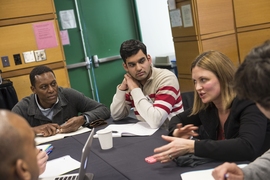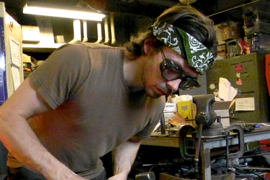Graduate students from the Joint Program on the Science and Policy of Global Change taught a series of classes in January as part of MIT’s annual Independent Activities Period (IAP) that were designed to quickly bring students and community members up to speed on basic climate science, climate policy, and the state of international climate negotiations.
International climate action
Amanda Giang, a graduate student in the Engineering Systems Division, led a session on Jan. 30 on recent climate negotiations. Climate change is a vexing international problem in part because it is a commons problem — a type of problem which many graduate students may already be familiar with, she said.
A dirty dorm-room kitchen is an example of a commons problem, said Giang. “We all share the kitchen, so it’s in no one’s best interest to clean the kitchen alone. If I clean the kitchen myself, I have to do all the work while everyone gets the benefit. But if no one cleans the kitchen we all suffer. What we really need is some sort of coordinated collective action, where I take out the trash and my roommate does the dishes.”
Because of this, an international agreement is the best route for action. Giang reviewed the recent history of global climate negotiations, including the UN’s efforts leading up to the next round of talks in Paris this winter, where countries are expected to come to an agreement on post-2020 climate action. Giang also discussed existing greenhouse gas mitigation efforts in the U.S. and China, and the recent emissions deal between the two countries.
Economic measurements
Paul Kishimoto, a graduate student in the Engineering Systems Division, led sessions on Jan. 29 and Jan. 30 on the economics of climate change and climate policy.
Economists measure the effects of climate change as costs, both direct and indirect. As an example, Kishimoto asked the class to consider how statistically warmer weather might affect a runner who goes jogging on the Charles. If the runner goes jogging when it’s too hot and gets heat stroke and has to go to the hospital, it is a cost directly related to climate change. If the runner avoids running and misses out on an activity that they would otherwise do, it’s counted as an indirect, or counterfactual, cost of climate change. Calculating both the costs of climate change and the costs of policies allows researchers to evaluate the effectiveness of policies addressing climate change, he said.
Kishimoto also discussed how different types of policies aimed at reducing greenhouse gas emissions work, including measures like carbon taxes and trading plans, regulations, and policies encouraging research and development of new technology.
Climate science measurements
Daniel Gilford and Jareth Holt, graduate students in the Department of Earth, Atmospheric and Planetary Sciences, led a session on Jan. 29 on how climate scientists measure climate change.
Gilford started the class out by explaining the concept of radiative forcing, a measure of the net difference between the energy the Earth and atmosphere absorbs from sunlight and the energy released back into space after a change in the atmospheric composition (such as increasing carbon dioxide). A change that traps more heat in the Earth system is a positive radiative forcing and contributes to warming. The primary gas causing increased radiative forcing is carbon dioxide, but other gases like methane, nitrous oxide, and ozone also play a role.
Jareth Holt discussed how climate models account for factors that affect radiative forcing. To do this, models have become more complex, Holt said. For example, in the 1990s, climate models underestimated the importance of aerosols in calculating radiative forcing, and had simple representations. Models now have more detailed representations of how aerosols behave in the atmosphere.
On the other hand, there are reasons why researchers might want to simplify models. Modern climate models use supercomputers, he explained, and can take weeks or even months to make one simulation. Simpler models run more quickly, and allow researchers to complete a larger number of simulations, helping to understand the uncertainty in the climate system. As a result, climate modeling requires constant balancing between complexity and computational efficiency.
Climate fundamentals
Daniel Gilford and Jareth Holt led a session on Jan. 26 covering basic climate science and the history of the discipline.
Climate science, Holt said, is the study of variability, patterns, and statistics over time. The field can trace its roots back to the 1820s, when Joseph Fourier discovered that the Earth’s atmosphere traps heat. The modern study of climate change got its start in the 1890s when Swedish scientist Svante Arrhenius built the first simple model balancing energy in the Earth system. He determined that adding carbon dioxide to the atmosphere traps energy, causing warming, which is a principle still used by climate scientists today.
Gilford and Holt also explained what makes a gas a greenhouse gas. The Earth’s atmosphere is made of mostly nitrogen and oxygen, but those gases absorb almost none of the energy given off by the Earth’s surface. Instead, small amounts of other gases, like water vapor and carbon dioxide, trap the most energy. Other gases like methane and nitrous oxide are present in even smaller amounts, but because they strongly absorb energy at different wavelengths than carbon dioxide and water vapor, they can also contribute dramatically to warming.









